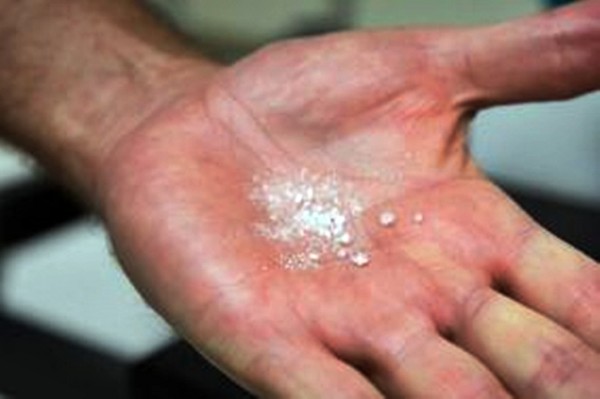‘Nanodiamonds’ from Crude Oil can Produce Excellent Optics and Electronics
| Arthur Dominic Villasanta | | Jun 24, 2016 10:36 AM EDT |
(Photo : Stanford University/SLAC) Diamondoids
Precisely flawed nanodiamonds so small some contain only a few atoms have the potential to make better microchips and far better electron microscope images.
Researchers from Stanford University and the U.S. Department of Energy's SLAC National Accelerator Laboratory jointly operate the world's top program for isolating and studying "diamondoids," the tiniest possible specks of diamond.
Like Us on Facebook
Diamondoids are found naturally in certain types of crude oil and are recovered in a very complex process that involves boiling crude oil again and again. The microscopic diamondoids are made of interlocking carbon cages that weigh less than a billionth of a billionth of a carat. The smallest contain just 10 atoms. A carat weighs about the same as 12 grains of rice.
Diamondoids, however, are invisible to the eye. They can only be seen because they clump together in fine, sugar-like crystals.
To produce diamondoids, small quantities of crude oil are repeatedly boiled to evaporate and isolate molecules of specific weights. These resulting fluids are then forced at high pressure through sophisticated filtration systems to filter out diamondoids of different sizes and shapes, each of which has different properties.
Over the past decade, a team led by two Stanford-SLAC faculty members found potential roles for diamondoids in improving electron microscope images, assembling materials and printing circuits on computer chips. These scientists are Nick Melosh, an associate professor of materials science and engineering and of photon science, and Zhi-Xun Shen, a professor of photon science and of physics and applied physics.
The team recently started using diamondoids to seed the growth of flawless, nano-sized diamonds in a lab at Stanford. By introducing other elements such as silicon or nickel during the growing process, they hope to make nanodiamonds with precisely tailored flaws that can produce single photons of light for next-generation optical communications and biological imaging.
Early results show that the quality of optical materials grown from diamondoid seeds is consistently high, according to Stanford's Jelena Vuckovic, a professor of electrical engineering who leads this part of the research with Steven Chu, professor of physics and of molecular and cellular physiology.
"Developing a reliable way of growing the nanodiamonds is critical," said Vuckovic. "And it's really great to have that source and the grower right here at Stanford. Our collaborators grow the material, we characterize it and we give them feedback right away. They can change whatever we want them to change."
Also part of the team are Jeremy Dahl, who developed key diamondoid isolation techniques, and fellow Chevron researcher Robert Carlson.
"We analyzed more than a thousand oils from around the world to see which had the highest concentrations of diamondoids," said Dahl.
"If you had a spoonful, you could give 100 billion of them to every person on Earth and still have some left over."
SLAC is a multi-program laboratory exploring frontier questions in photon science, astrophysics, particle physics and accelerator research. It's operated by Stanford University for the U.S. Department of Energy's Office of Science.
Tagsnanodiamonds, diamondoids, Stanford University, SLAC National Accelerator Laboratory
©2015 Chinatopix All rights reserved. Do not reproduce without permission
EDITOR'S PICKS
-

Did the Trump administration just announce plans for a trade war with ‘hostile’ China and Russia?
-

US Senate passes Taiwan travel bill slammed by China
-

As Yan Sihong’s family grieves, here are other Chinese students who went missing abroad. Some have never been found
-

Beijing blasts Western critics who ‘smear China’ with the term sharp power
-

China Envoy Seeks to Defuse Tensions With U.S. as a Trade War Brews
-

Singapore's Deputy PM Provides Bitcoin Vote of Confidence Amid China's Blanket Bans
-

China warns investors over risks in overseas virtual currency trading
-

Chinese government most trustworthy: survey
-

Kashima Antlers On Course For Back-To-Back Titles
MOST POPULAR
LATEST NEWS
Zhou Yongkang: China's Former Security Chief Sentenced to Life in Prison

China's former Chief of the Ministry of Public Security, Zhou Yongkang, has been given a life sentence after he was found guilty of abusing his office, bribery and deliberately ... Full Article
TRENDING STORY

China Pork Prices Expected to Stabilize As The Supplies Recover

Elephone P9000 Smartphone is now on Sale on Amazon India

There's a Big Chance Cliffhangers Won't Still Be Resolved When Grey's Anatomy Season 13 Returns

Supreme Court Ruled on Samsung vs Apple Dispute for Patent Infringement

Microsoft Surface Pro 5 Rumors and Release Date: What is the Latest?












